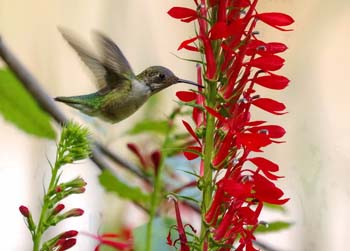Sage Words About Wildlife: Hummingbirds Love Lobelias

If hummingbirds could speak, they would buzz gardeners' ears demanding, "Plant Lobelia. Plant Salvia. Do… it… now! Becauzzze they're tazzzty. "
Top-10 lists of hummingbird favorites almost always contain Salvia and Lobelia, because each genus is nectar rich and offers many species in bright reds, oranges and pinks.
 Hummingbirds have a weak sense of smell, but bright colors lure them to flowerbeds. Australian scientists provide a clue to understanding this behavior. They theorize that unlike bees, their nation's honeyeater birds -- which have long beaks similar to those of hummers -- are drawn to the red spectrum because the birds' vision is better adapted to the long wavelengths of the red spectrum.
Hummingbirds have a weak sense of smell, but bright colors lure them to flowerbeds. Australian scientists provide a clue to understanding this behavior. They theorize that unlike bees, their nation's honeyeater birds -- which have long beaks similar to those of hummers -- are drawn to the red spectrum because the birds' vision is better adapted to the long wavelengths of the red spectrum.
Matching Cultural Needs
Once hummingbirds pause for red in your garden, they'll test out plants of other colors that have tubular flowers. They're especially drawn to ones, such as Lobelias, that are native to the Western Hemisphere. This is probably because hummingbirds are native to the western half of the world and favor what is familiar.
Lobelias are great Salvia garden companion plants as long as you match them with sages that share their cultural needs. For example, many Lobelias -- particularly Cardinal Flower (L. cardinalis) and its hybrids -- love moist soil. In the wild, they favor life in meadows, along the shores of waterways and in bogs and other wetlands. Two water-loving matches are Big Swing Sage (Salvia x 'Big Swing') and Bog Sage (S. uliginosa).
Other Lobelias, including the Arizona native Sierra Madre Cardinal Flower ( L. laxiflora var angustifolia) prefer somewhat drier conditions and can tolerate drought. Sierra Madre pairs well with Jame Sages, such as Tangerine Ballet Hybrid Jame Sage (S. x jamensis 'Tangerine Ballet').
Co-evolving with Tubular Flowers
Ninety percent of a hummingbird's diet is nectar. The remaining 10 percent comes from pollen and insects. Hummingbirds gather all these foods from plants with tubular flowers that have co-evolved to be just the right fit for long narrow beaks.
For example, it appears that the Ruby-throated hummingbird ( Archilochus colubris) and Cardinal Flower co-evolved to meet each other's needs. The bird, which predominately migrates up the Atlantic coast, dines on Cardinal Flower along its entire travel route.
According to a study of Cardinal Flower pollination in the March 2012 issue of the journal New Phytologist, the plant is only pollinated by Ruby-throats within its Canadian range.
Despite proliferating on the East Coast, Cardinal Flower is native to most of the U.S., including states known for dry climates.
Battling for Lobelia
Dining isn't peaceful for hummingbirds. First, they have to work hard for each sip as they beat their wings rapidly in a figure-eight pattern while hovering. Second, they zip from blossom to blossom seemingly nonstop to fill up.
Here's a good video demonstrating a hummingbird hard at work among red Lobelia flowers.
Third, hummingbirds aren't keen on sharing. They have to consume lots of nectar and eat plenty of insects to fuel daily life, which may include long migratory stretches. So they expend energy keeping other hummingbirds away from their favorite plants.
One of our favorites at Flowers by the Sea is Giant Red Cardinal Flower (Lobelia x speciosa 'Compliment Deep Red'). Hummingbirds commonly pester us whenever we work near it.
One follower of our Facebook page recalls watching hummingbirds chase a child in his backyard after the child clipped some Lobelia stems and tried to walk away with them. "He dropped the flower heads right there and ran off."
Pollinating, Propagating and Perennializing
Lobelias contain both male and female flowers on the same plants. This characteristic is called protandry.
The male flowers turn into female flowers as they age. Hummingbirds visit the male flowers first, because they have richer nectar. As they drink from male flowers, pollen from the male stamens collects on their heads. When the birds subsequently sip at female flowers, they transfer pollen to the female pistil.
Another distinctive -- and perhaps confusing -- characteristic of Lobelias is that they aren't truly perennial. Herbaceous growth and roots die after Lobelias set seeds. However, they seem perennial, because new roots develop from lateral shoots set by the lowest leaves on the plant. These become basal rosettes that overwinter to bloom the following growing season.
Also, if they are growing in persistently moist soil, Cardinal Flowers sometimes reseed. Unlike Salvias, which can suffer crown and root rot from mulching during the growing season, Cardinal Flowers benefit from it. You should surround, but not cover, the basal leaves with a layer of organic matter, such as grass clippings, wood chips or leaves. During winter in areas with moderate temperatures, mulch shouldn't cover the basal rosettes.
Growing Lobelias
There are more than 400 species of Lobelia worldwide. Forty-three are native to America. These include L. cardinalis, L. laxiflora and L. x speciosa (a cross of L. cardinalis and L. siphilitica). Lobelia siphilitica once was thought to cure syphilis.
Based on our observations, including persistent head and shoulder bombing, hummingbirds are devoted to all our Lobelias, a number of which also attract butterflies. One species, Lobelia x speciosa 'Compliment Deep Red', is a magnet for honeybees as well. All our Lobelias prefer rich soil and grow well with average watering, but love ample moisture. Their USDA Plant Hardiness Zones start as low as Zone 4. These classifications concern the most extreme winter temperatures plants reliably tolerate.
Lobelia Choices at FBTS
Queen Victoria Cardinal Flower (Lobelia cardinalis 'Queen Victoria') Zones 4 to 10
- Crimson flowers bloom summer to fall
- 36 inches tall, 24 inches wide in bloom
- Lance-shaped, burgundy foliage
- Full sun or partial shade
- Heat and cold tolerant
- Attracts butterflies and hummingbirds, but not deer
Giant Red Cardinal Flower (Lobelia x speciosa 'Compliment Deep Red') Zones 6 to 10
- Cardinal red flowers bloom in summer
- 36 inches tall, 24 inches wide in bloom
- Lance-shaped, mid-green foliage
- Full sun
- Heat and cold tolerant
- Attracts butterflies, honeybees and hummingbirds, but not deer
Sierra Madre Cardinal Flower (Lobelia laxiflora var angustifolia) Zones 6 to 10
- Scarlet and orange bicolor flowers bloom summer into fall
- 36 inches tall, 24 inches wide in bloom
- Long, lance-shaped, mid-green foliage
- Full sun, partial shade
- Heat resistant, moderately cold resistant
- Attracts butterflies and hummingbirds, but not deer
Thanking Hummingbirds and Asking Questions
Whatever it is that hummingbirds see when they look at all the flowers they covet, we are thankful for their vision and taste for nectar. Their pollination makes our world so colorful. Consequently, we'd like to encourage you to feed them what they enjoy and need -- Lobelias and Salvias.
If you have more questions about FBTS hummingbird plants, please feel free to email us or call. Also, please check our Everything Salvias Blog for additional hummingbird articles at Sage Words About Wildlife and Hummingbirds in the Garden.

 Salvia uliginosa
Salvia uliginosa  Salvia x 'Big Swing'
Salvia x 'Big Swing'
Comments
There are no comments yet.